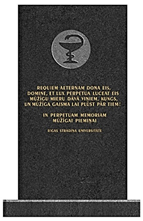History
The time period between 2002 and 2016 brought winds of change to the old and stately Theatrum Anatomicum building. Certain traditions and practices have taken root in the everyday life of the RSU IAA, even though some of them might be considered unconventional.
One such thing has been to re-establish contact with the relatives of Swedish Professor Gaston Backman. The professor was invited to Latvia in 1920 and adapted the Theatrum Anatomicum to the needs of the growing medical staff. In Prof. Backman’s family, only one of this two brothers, Pierre, had children. Like his brothers, Pierre was also fond of Latvia and, being a journalist, wrote a lot about it. His daughter Christine and her children and grandchildren live in Sweden. The Director of IAA was able to get in touch with Christine Backman in Uppsala, Sweden. Christine attended the international conference devoted to the 120th anniversary of Prof. Backman in 2003 together with her granddaughter, Anna Backman Klein. Since then an oil portrait of a young Gaston Backman and his original diploma signed by King Gustaf V of Sweden hang the IAA director’s office.
An important tradition that has been introduced is a commemorative service and the creation of a final resting place in Mārtiņa Kapi (the Martin Cemetery) for people who have dedicated their lives to academia and science (the image below depicts the monument in Mārtiņa Kapi).
The idea for the monument was born at IAA and was supported by the university. A granite monument decorates the grave in Mārtiņa Kapi since 2016. The monument bears an inscription in both Latin and Latvian:
Requiem aeternam dona eis,
Domine, et lux perpetua luceat eis!
In perpetuam memoriam,
Rīga Stradiņš University
Eternal rest, grant unto them,
And let perpetual light shine upon them!
In perpetual memory,
Rīga Stradiņš University

The Theatrum Anatomicum Museum is located in the building of the institute. The museum contains exhibits of organs and tissue donated by various Latvian hospitals, a collection of personal belongings that once belonged to professors Pēteris Gērke, Jānis Eglītis, and Irma Liepiņa-Eglītis, a small collection of micropreparations that reflects changes in the preparation of micropreparations over the century, and a collection of microscopes. The restored collection was opened on 31 January 2003. See the Theatrum Anatomicum Museum website for more information.
The Theatrum Anatomicum hosts book presentations for publications related to medicine: the Latvian translation of Hippocrates’ Hippocratic Writings was presented on 3 December 2003; Latviešu kauli (Latvian Bones) by Kārlis Arājs was presented on 3 February 2006; Medicīniskā embrioloģija (Medical Embryology) by Prof. Māra Pilmane and Gert-Horst Schumacher was presented on 3 October 2006.
The Institute of Anatomy and Anthropology has prioritised reviving the Baltic Morphology conferences since Latvia regained its independence. The first such conference which was attended by 24 international delegates and was held in December 2003. There have been eight conferences since then, of which the institute organised two (in 2007 and 2013).



